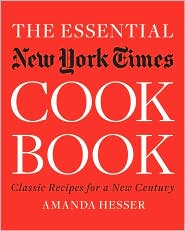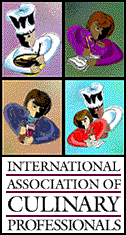Recipe of the Day Categories:
 Recipe Home Recipe Home
 Recipe Index
Recipe Index
 Recipe Search
Recipe Search
 Appetizers Appetizers
 Beef
Beef
 Beverage
Beverage
 Bread
Bread
 Breakfast Breakfast
 Cake Cake
 Chocolate Chocolate
 Cookies Cookies
 Fish Fish
 Fruit Fruit
 Main Dish
Main Dish
 Pasta
Pasta
 Pies Pies
 Pork Pork
 Poultry Poultry
 Salad Salad
 Seafood Seafood
 Side Dish Side Dish
 Soup Soup
 Vegetable Vegetable
 Surprise! Surprise!
![[Flag Campaign icon]](http://a1032.g.akamai.net/f/1032/81/30m/www.gamesville.lycos.com/art_gv/ribbon_small.gif)


Leek Stalks
Photographic Print
Baxter, Steve
Buy at AllPosters.com
Also by
Amanda Hesser
 
Cooking for Mr.
Latte: A Food
Lover's Courtship
with Recipes
 
The Essential New York Times Cookbook: Classic Recipes for a New Century


Carrots (Carottes)
Giclee Print
Ochoa, Isy
Buy at AllPosters.com


Mixed Herbs
Art Print
Buy at AllPosters.com

Rhubarb and...
Jan-peter ...
Buy This at Allposters.com
Other books we think you'll enjoy:
 
Provence Cookbook: 150 Recipes and Select Guide to the Markets, Shops, and Restaurants of France
|
|
Your
patronage of our affiliate
partners supports this web site.
We thank you! In other words, please shop at LBC
Gift Galerie!

Old Books I
Art Print
Belkovskij, Igor
Buy at AllPosters.com

La Belle Cuisine

IACP Cookbook Award Winner
Literary Food Writing
(Non-fiction or fiction food or beverage books that are
distinguished
by the quality of their prose)
 
Cook and the Gardener:
A Year of Recipes and Writings
from the French Countryside
Amanda Hesser, 1999, W. W. Norton & Company
Creamy Leeks and Tarragon on Toast
"The leeks of
last season still sit in the ground, thick, and sweetened from
age and frost, not from the
sun's rays. The starch in leeks converts to
sugar as it gets old. As the days get warmer
in the spring, the leeks begin
to harden, bracing themselves for their final bolt toward
the sky, when
they will produce a pretty topiary ball of flowers, which ultimately turns
to seed. It looks like a great overgrown puffball, reaching a final height
of five feet or
more.
Here I used the sweet old leeks in a way that salvages what flavor they
have left.
(If the core of the leek has hardened, the leeks are too old to
use.)
The leeks
are bound with cream and soft goat's milk cheese, then
scented
with the anise-flavor
of
tarragon and mounded on toast rubbed
with garlic.
Perfect for an appetizer or light lunch
paired with a salad
or soup."
Serves 4
2 medium leeks, trimmed, cut in half
lengthwise and washed
2 tablespoons butter
Coarse or kosher salt
1/3 cup heavy cream
1/4 cup soft goat's milk cheese
(usually sold as logs in vacuum-packed
plastic),
with rind (if there is one) removed,
and broken into small pea-size pieces
2 tablespoons chopped flat-leaf parsley
leaves (about 6 sprigs)
1-1/2 tablespoons chopped tarragon
leaves (about 4-5 branches)
Freshly ground black pepper
4 slices crusty bread, toasted in the oven
1 clove garlic
1. Slice the leeks crosswise to make 1/4-inch half-moons. Melt the
butter in a large sauté pan. Add the leek and cook over low heat so
it softens but does
not color. Once the leek is meltingly soft (8 to
10 minutes), turn up the heat to high to
cook off excess liquid, 1
to 2 minutes. Reduce heat to medium-low and pour in the cream.
Reduce to thicken, about 1 minute. Add the goat's milk cheese
and stir until it is melted
and the mixture is well bound. Add the
parsley and tarragon and season to taste with
pepper. Remove
from the heat and set aside but keep warm.
2. Rub the slices of bread with the garlic clove. Mound the leeks
on the
toast and serve.
Grilled Lamb Chops with Warm
Tomato-Mint Vinaigrette
Serves 4
Special Equipment: Grill
Warm Tomato-Mint Vinaigrette:
1-1/2 tablespoons red wine vinegar
1-1/2 teaspoons Dijon mustard
Coarse or kosher salt
4-1/2 tablespoons best-quality olive oil
1 large very ripe tomato, peeled, seeded,
and chopped fine
3 sprigs mint, leaves stripped and left whole
12 lamb chops (about 1 - 1-1/4 inches thick)
Coarse or kosher salt
Freshly ground black pepper
1. Heat the grill. The cooking rack should be about 5 or 6 inches from
the charcoal or wood.
2. While it heats, make the vinaigrette: In a small bowl combine the
vinegar, mustard, and salt and whisk until the mustard is broken
up and the salt has
dissolved. Then slowly add the olive oil, first
a few drops at a time, then in a slow,
steady stream, whisking
constantly to emulsify the dressing. Combine the dressing and
tomato
in a small saucepan and warm over low heat. You want
it to warm
just enough to
bring out all the flavor in the tomato.
Keep warm
while you grill the lamb chops.
3. Place the chops on the heated grill and let color, 4 to 5 minutes.
Using tongs turn the chops and color the other side, another 4 to
5
minutes. If
you like
your lamb medium to well done, grill them
1 to 2 minutes more
on each side.
4. Remove the chops to a serving plate and season them with salt and
freshly ground black pepper. Whisk warm vinaigrette to re-emulsify
it, then add the
mint leaves. Spoon the vinaigrette over the chops and
serve immediately. If, for some
reason, you wish to hold this, make
sure you don't add the mint until serving, or it will
turn black. Another
interesting way to serve this is to make a bed of spicy greens, such
as
arugula and mustard, on the serving plate, then lay the lamb chops on
top of them. The
juices from the lamb
and the vinaigrette will dress
and lightly wilt the greens as the
dish is carried to the table.
Note: If you don't have a grill, the lamb chops may also be broiled.
Heat the broiler. Place the lamb chops on a rack 3 to 4 inches from
the heating element and broil 3 to 5 minutes on each side.
Carrot
and Bay Leaf Salad
"This is a
year-round salad. The ribbons of carrot curl and tangle
together, wrapping around the
fragrance of the garlic and bay.
Note that this salad
needs
at least 8 hours to marinate."
Serves 4
6 - 8 medium carrots (about 3/4 - 1 pound),
trimmed and peeled
Sea salt
2 bay leaves
1 clove garlic
Coarse or kosher salt
Freshly ground black pepper
About 1/3 cup good-quality olive oil
1. Fill a medium saucepan with water, season with salt, and bring the
water to a boil. Meanwhile, prepare the carrots: Pinching the wide
end of a carrot between
your fingers or holding it down with a fork,
use a vegetable peeler
to peel along the
length of the carrot from
the wide end to the narrow end
-- you'll get more out of the
carrot
by peeling in this direction. Peel one
strip, then turn the carrot over
so it has a
flat side to rest on and peel from the other side. You
will end up with long wide strips,
which should be thin enough to
wrap around your thumb without snapping. Continue peeling
until you can no longer make nice wide strips. Save the stub of
carrot for stock. Peel all
of the carrots in this manner.
2. When the water comes to a full boil, pile the carrot strips into the
water
in handfuls and stir so that they all fit in the water. Bring
the water back
to a
boil and cook for 1 to 2 minutes, until the
carrot strips have relaxed
slightly but are
still crisp (they should
just break when pinched); their
color should intensify.
3. Have a bowl of cold water ready. Drain the carrots and plunge
them into the cold water to stop the cooking. Drain again, then
lay the strips loosely
on a
dish towel so they dry thoroughly. If
they are at all wet when it's time
to pour the oil
over them,
they will repel the oil.
4. In a medium mixing bowl, combine the carrots, bay leaves, and
garlic.
Taste a carrot. If you put enough sea salt in the boiling
water, you will not need to
season them any further, but if not,
season with both salt and freshly ground black
pepper. Pour the
olive oil over them and toss gently to mix.
5. Press the carrots down so they are compacted together and well
dressed with oil. Press a piece of plastic wrap down onto them.
Refrigerate and
let
marinate for at least 8 hours. Before serving,
let the salad sit at room temperature for
about 30 minutes so
the olive oil loosens up. Then toss to mix once more and taste
for
seasoning. Transfer to a serving bowl and use
a fork to lift
and fluff the ribbons of
carrot. Discard the garlic. The bay
leaves, however, should be made visible -- for
"eye appeal."
If you are
lucky enough to have a bay tree, why not arrange the
salad on top of a
bed of bay leaves on a simple flat white plate?
Crisp Rhubarb Preserve
"Rhubarb
multiplies easily and can grow to mammoth proportions. The
root of
the plant is
log-shaped, and from this log, several plants can shoot
up each year.
Then, just when you're not looking, the rhubarb will bolt to
seed,
lifting its thick trunk high above the plant and releasing a shag of
seed pods, which
resemble miniature cross sections of an apple. Eventu-
ally, the ribs, which are used for
cooking, wane and become pithy, mark-
ing the end to rhubarb's season.
This recipe was adapted from one created by Anne Willan and used at the
Ecole
de Cuisine La Varenne. It can be made without the berry leaves."
Serves 4
1 pound rhubarb stalks, peeled and sliced thin
1/2 cup white wine
1 cup sugar, or more if needed
4-5 boysenberry leaves
4-5 strawberry leaves
4-5 raspberry leaves
1 bag Ceylon tea
1 pint strawberries, washed, hulled,
and halved (see note)
Vanilla ice cream (optional)
1. Place the rhubarb in a large heatproof bowl. Bring 1 cup of water,
the wine, and the sugar to a boil, stirring to dissolve the sugar. Then
turn off the heat.
Add the berry leaves and tea and let infuse for 15
minutes. Bring back to a boil and
strain over the rhubarb. Cover the
bowl with plastic wrap to contain the heat and to
create a hermetic
atmosphere in which the rhubarb can absorb the flavors of the infu-
sion. Let cool, then refrigerate for at least 8 hours, to crisp the
rhubarb and allow it to
imbibe the flavors further.
2. Before serving taste the syrup, adding more sugar if desired, and
the
strawberries. Ladle into tall parfait glasses or small flat bowls.
If serving with ice
cream, place one scoop in each glass and ladle
the rhubarb over it.
Note:
Strawberries may not yet be in season; in this case, either omit
them,
or if you have fruit preserved in alcohol (e.g., raspberries
eau-de-vie) from the
previous year, substitute these.
Index - Cookbook Features
Classic French Recipe Index
Daily Recipe Index
Recipe Archives Index
Recipe Search
Click for winners in other categories:
American Category
Bread, Other Baking and Sweets
Chefs and Restaurants
Food Reference/Technical
General
Health and Special Diet
International
Single Subject
Wine, Beer or Spirits
The 1999 IACP Award Winner -
Literary Food Writing
Apples: The Story of
the Fruit of Temptation
 
|













